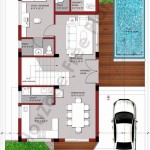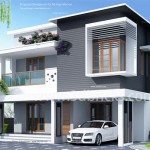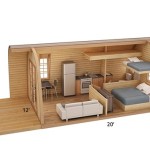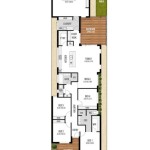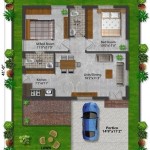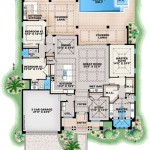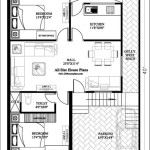3000 Square Feet House Floor Plans: Designing for Space and Functionality
The design of a 3000 square feet house floor plan presents a significant opportunity to create a comfortable, functional, and aesthetically pleasing living space. This size typically allows for a balance between spaciousness and manageability, offering ample room for families, individuals who enjoy hosting, or those pursuing hobbies requiring dedicated areas. Successful planning hinges on carefully considering lifestyle needs, prioritizing specific rooms and features, and optimizing the flow of movement throughout the house.
When embarking on a 3000 square feet house floor plan project, it's crucial to begin with a comprehensive needs assessment. This involves identifying the number of occupants, their ages, and their specific requirements for space and privacy. Factors such as work-from-home arrangements, hobbies, entertaining habits, and long-term plans for the property should all be taken into account. A well-defined needs assessment forms the foundation for making informed decisions about the layout and allocation of square footage.
The architectural style also plays a crucial role in shaping the floor plan. Whether opting for a modern, traditional, farmhouse, or contemporary design, the style will influence the overall aesthetic and the arrangement of rooms. Different architectural styles often have characteristic features, such as open-concept living areas in modern designs or designated formal spaces in traditional styles. Integrating the desired architectural style seamlessly into the floor plan is essential for creating a cohesive and visually appealing home.
The orientation of the house on the lot is another critical consideration. Maximizing natural light and taking advantage of scenic views can significantly enhance the living experience. Thoughtful placement of windows and doors, along with the strategic positioning of rooms, can optimize sunlight exposure and minimize unwanted heat gain. Consideration should also be given to prevailing winds and seasonal changes to ensure the house is comfortable year-round.
The budget is a primary constraint in any construction project. Developing a realistic budget early on is essential for making informed decisions about the size, features, and materials used in the house. It's important to allocate funds not only for construction costs but also for landscaping, interior design, and unforeseen expenses. Regular budget reviews can help ensure the project stays on track and within financial limitations.
Key Point 1: Optimizing Space Allocation in a 3000 Square Feet House
One of the primary considerations in designing a 3000 square feet house floor plan is the allocation of space to different areas of the home. This involves determining the size and configuration of bedrooms, bathrooms, living areas, kitchen, dining room, home office, and any other specialized spaces. The optimal allocation of space should reflect the occupants' lifestyles and priorities.
Bedrooms are typically a significant component of any house floor plan. The number of bedrooms and their size should be determined based on the number of occupants and their need for privacy. Master suites often include a spacious bedroom, a walk-in closet, and a luxurious bathroom. Secondary bedrooms can be designed with a range of sizes to accommodate different needs. Consider the possibility of incorporating a guest suite with a private bathroom for visitors.
Bathrooms are essential for both functionality and comfort. Master bathrooms frequently feature double vanities, separate showers and tubs, and ample storage space. Secondary bathrooms can be designed with a focus on efficiency and practicality. The placement of bathrooms should be carefully considered to ensure convenient access from bedrooms and living areas. Powder rooms, typically located near the entrance or living areas, provide a convenient option for guests.
Living areas are often the heart of the home. Open-concept living areas, combining the living room, kitchen, and dining room, are popular in modern designs. These spaces promote interaction and create a sense of spaciousness. Formal living rooms can also be incorporated for more traditional designs. The size and layout of the living area should be conducive to both everyday living and entertaining.
The kitchen is a critical area that requires careful planning. The size and layout of the kitchen should be determined based on cooking habits and storage needs. A well-designed kitchen typically includes ample counter space, plenty of storage cabinets, and a functional layout that promotes efficient workflow. Islands and peninsulas can provide additional counter space and seating. Incorporating a pantry is essential for storing food and kitchen supplies.
Dining rooms can range from formal dining rooms to casual dining areas adjacent to the kitchen. Formal dining rooms provide a dedicated space for entertaining and special occasions. Casual dining areas are ideal for everyday meals and informal gatherings. The size and location of the dining room should be carefully considered to ensure it complements the overall flow of the house.
Home offices have become increasingly important in recent years due to the rise of remote work. A dedicated home office provides a quiet and productive workspace. The size and layout of the home office should be determined based on work requirements and equipment needs. Natural light and ventilation are essential for creating a comfortable and productive workspace.
Finally, consider allocating space for essential areas such as laundry rooms, mudrooms, and storage. Laundry rooms provide a dedicated space for washing, drying, and ironing clothes. Mudrooms provide a transition space between the outdoors and indoors, helping to keep the house clean. Adequate storage space is essential for organizing belongings and preventing clutter.
Key Point 2: Prioritizing Circulation and Flow in a Floor Plan
The circulation and flow of movement throughout a house are critical aspects of its functionality and livability. A well-designed floor plan should facilitate easy and intuitive movement between rooms, minimizing bottlenecks and maximizing convenience. Thoughtful consideration of hallways, doorways, and transitions between spaces can significantly enhance the overall living experience.
Hallways play a crucial role in connecting different areas of the house. The width of hallways should be sufficient to allow for comfortable passage, even when carrying items. Minimizing the length of hallways can help to maximize usable floor space. Hallways should be well-lit and visually appealing, serving as more than just functional passageways.
Doorways are essential for defining spaces and controlling access. The width of doorways should be adequate to accommodate furniture and wheelchairs. The placement of doorways should be carefully considered to minimize disruption to traffic flow. Pocket doors and sliding doors can be used to save space and create a more open feel.
Transitions between spaces should be seamless and intuitive. The use of archways, changes in flooring, and variations in ceiling height can help to define different areas while maintaining a sense of continuity. Avoid abrupt transitions that can disrupt the flow of movement. Consider the use of transitional spaces, such as foyers and landings, to provide a buffer between different areas.
Vertical circulation, such as stairs, should be carefully planned to ensure safety and ease of use. The width and rise of stairs should comply with building codes. The placement of stairs should be convenient and accessible from multiple areas of the house. Consider the use of landings to provide resting points along the stairway. Railings should be sturdy and visually appealing, enhancing the overall aesthetic of the house.
Consider the relationship between different rooms and their proximity to each other. For example, the kitchen should be located near the dining room to facilitate easy serving. The bedrooms should be located away from noisy areas, such as the living room, to ensure privacy and quiet. The placement of the laundry room should be convenient to bedrooms and bathrooms. The overall layout should promote a logical and efficient flow of movement throughout the house.
Think about the impact of furniture placement on circulation. A well-designed floor plan should allow for flexible furniture arrangements without obstructing pathways or creating bottlenecks. Consider the size and shape of furniture when planning the layout of rooms. Ensure there is adequate space for moving around furniture and accessing doorways and windows.
Universal design principles can be incorporated to create a more accessible and user-friendly home. These principles include wider doorways, ramps instead of stairs, grab bars in bathrooms, and adjustable-height countertops. Universal design benefits not only people with disabilities but also individuals of all ages and abilities.
Key Point 3: Integrating Desired Features and Amenities
A 3000 square feet house floor plan allows for the incorporation of a variety of desired features and amenities. These features can enhance the functionality, comfort, and aesthetic appeal of the home. Careful consideration should be given to which features are most important and how they can be integrated seamlessly into the overall design.
Outdoor living spaces are increasingly popular and can significantly enhance the living experience. Patios, decks, and porches provide opportunities for outdoor dining, relaxation, and entertaining. The size and layout of outdoor living spaces should be determined based on lifestyle and preferences. Consider the use of outdoor kitchens, fireplaces, and seating areas to create inviting and functional outdoor spaces.
Garages provide secure parking for vehicles and additional storage space. The size of the garage should be determined based on the number of vehicles and storage needs. Garages can be attached to the house or detached. Attached garages provide convenient access to the house, while detached garages can offer more privacy and separation. Consider incorporating a workshop area in the garage for hobbies and projects.
Home theaters provide a dedicated space for watching movies and enjoying entertainment. A well-designed home theater should include comfortable seating, a large screen, and a high-quality sound system. Soundproofing the room can help to minimize noise disturbance. Consider incorporating a wet bar or kitchenette for added convenience.
Game rooms provide a fun and recreational space for family and friends. A game room can include a pool table, a ping pong table, a foosball table, or other games. The size of the game room should be determined based on the types of games and activities desired. Consider incorporating a bar area or a lounge area for relaxation.
Wine cellars provide a dedicated space for storing and aging wine. A well-designed wine cellar should maintain a consistent temperature and humidity level. The size of the wine cellar should be determined based on the number of bottles to be stored. Consider incorporating a tasting area for enjoying wine with friends.
Swimming pools and spas provide opportunities for recreation and relaxation. The size and shape of the pool should be determined based on lifestyle and preferences. Consider incorporating a deck or patio area around the pool for lounging and entertaining. Spas can be integrated into the pool or located separately. Heaters and covers can extend the swimming season.
Green features can enhance the sustainability and energy efficiency of the home. Solar panels can generate electricity and reduce energy costs. Energy-efficient appliances and lighting can further reduce energy consumption. Rainwater harvesting systems can collect rainwater for irrigation and other uses. Green building materials can reduce the environmental impact of construction. Proper insulation and ventilation can improve indoor air quality and reduce energy waste.
Ultimately, the successful design of a 3000 square feet house floor plan requires careful planning, attention to detail, and a clear understanding of the occupants' needs and preferences. By optimizing space allocation, prioritizing circulation and flow, and integrating desired features and amenities, it is possible to create a home that is both functional and aesthetically pleasing.

3 000 Square Foot House Plans Houseplans Blog Com

European Style House Plan 3 Beds 2 5 Baths 3001 Sq Ft 52 150 Plans One Story Ranch With Pictures

3 000 Square Foot House Plans Houseplans Blog Com

3 000 Square Foot House Plans Houseplans Blog Com

House Drawing 2 Story 3000 Sq Ft Designs And Floor Plans Blueprints Two One
Country Ranch House Plan 3 5 Bedrm Bath 3000 Sq Ft 141 1005

Ranch Style House Plans 3000 Square Foot Home 1 Story 4 Bedroom And 3 Bath Garage Stalls By Floor

What Are Some 3000 Sq Ft G 1 Home Designs In

3000 Sq Ft House Plans Free Home Floor Houseplans Com Kerala

House Plan 59947 Craftsman Style With 2800 Sq Ft 4 Bed 3 Bath

